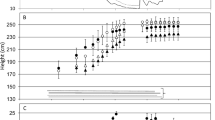Abstract
Experiments with fast-growing tree species for biomass production in Germany have been mainly focused on the growth performance of Populus and Salix spp. Among the lesser-known species for energy plantations is Robinia pseudoacacia L. Special features of this species are its drought tolerance and its ability to fix nitrogen. Given the large share of marginal arable land in NE-Germany and the predicted climate change, R. pseudoacacia is expected to grow in importance. In order to evaluate the growth performance of this species under extreme conditions, four experiments were established in the post-mining landscape of the Lusatian lignite-mining district (NE-Germany). Biomass production was estimated for 3- to 14-year-old shoots on 4- to 14-year-old roots. Results for the annual production of oven-dried biomass of R. pseudoacacia ranged between 3 and 10 t ha−1, which was substantially greater than the biomass of poplar and willow clones established on the same site. Economic analysis results show that the rotation period, the duration of the plantation, and the harvesting costs are important parameters for the economic return and cash flow in short-rotation coppice cultivation. The results show that the cultivation of R. pseudoacacia is an economically competitive land-use strategy for the post-mining landscapes considered in our study.



Similar content being viewed by others
References
Bullard MJ, Mustill SJ, Carver P, Nixon PMI, Britt CP (2002) Yield improvements through modification of planting density and harvest frequency in short rotation coppice Salix spp.—1. Yield response in two morphologically diverse varieties. Biomass Bioenerg 22:15–25
Bungart R (1999) Erzeugung von Biomasse zur energetischen Nutzung durch den Anbau schnellwachsender Baumarten auf Kippsubstraten des Lausitzer Braunkohlereviers. Cottbuser Schriften zu Bodenschutz und Rekultivierung 7
Bungart R, Hüttl RF (2004) Growth dynamics and biomass accumulation of 8-year-old hybrid poplar clones in a short-rotation plantation on a clayey–sandy mining substrate with respect to plant nutrition and water budget. Eur J Forest Res 123:105–115
Burger F, Sommer W (2003) Von der Pappel bis zum Hackschnitzel. LWF aktuell 39:4–6
Dickmann D, Steinbeck K, Skinner T (1985) Leaf Area and biomass in mixed and pure plantations of sycamore and black locust in the Georgia Piedmont. Forest Sci 31(2):509–517
Drebenstedt C (1998) Planungsgrundlagen der Wiedernutzbarmachung. In: Pflug W (ed) Braunkohletagebau und Rekultivierung. Springer, Berlin, pp 487–512
European Commission (2005) Biomass action plan. Communication from the Commission of the European Communities, COM(2005)-628-final. Brussels, Belgium
Fomundam FF (2007) The influence of rotation period on growth performance and biomass production of willow, poplar and black locust. Master thesis at Brandenburg University of Technology, Cottbus
Foster C (1992) Wood fuel production from short rotation coppice. Vegetation management in forestry, amenity and conservation areas. Asp Appl Biol 29:233–239
Gerstengarbe F, Badeck F, Hattermann F, Krysanova V, Lahmer W, Lasch P et al. (2003) Studie zur klimatischen Entwicklung im Land Brandenburg bis 2055 und deren Auswirkungen auf den Wasserhaushalt, die Forst- und Landwirtschaft sowie die Ableitung erster Perspektiven. PIK report no. 83, Potsdam Institute for Climate Impact Research
Geyer WA (1989) Biomass yield potential of short-rotation hardwoods in the Great Plains. Biomass 20:167–175
Grünewald H, Brandt BKV, Schneider BU, Bens O, Kendzia G, Hüttl RF (2007) Agroforestry systems for the production of woody biomass for energy transformation purposes. Ecol Eng 29:319–328
Grundmann P, Eberts J (2009) Oekonomische Bewertung von Kurzumtriebsholz: Verfahrensvergleich mit landwirtschaftlichen Kulturen im regionalen Kontext. In: Reeg T, Bemmann W, Konold D, Murach D, Spiecker H (eds) Anbau und Nutzung von Baeumen auf landwirtschaftlichen Flächen. Wiley-VCH, Weinheim
Hanff H, Neubert G, Brudel H (2005) Datensammlung für die Betriebsplanung und die betriebswirtschaftliche Bewertung landwirtschaftlicher Produktionsverfahren im Land Brandenburg, Schriftenreihe des Landesamtes für Verbraucherschutz. Landwirtschaft und Flurneuordnung (LVLF), Potsdam
Hanover JW, Mebrahtu T (1991) Robinia pseudoacacia: Temperate Legume Tree with Worldwide Potential. NFT Highlights, NFTA 91-03
Heath MC, Bullard MJ, Kilpatrick JP, Speller CS (1995) A comparison of the production and economics of biomass crops for use in agriculture and set-aside land. Asp Appl Biol 40:505–558
Heinsdorf D (1992) Untersuchungen zur Duengebeduerftigkeit von Forstkulturen auf Kipprohboeden der Niederlausitz. Dissertation, Technical University Dresden
Hofmann-Schielle C, Jug A, Makeschin F, Rehfuess KE (1999) Short-rotation plantations of balsam poplars, aspen and willows on former arable land in the Federal Republic of Germany. I. Site-growth relationships. For Ecol Manage 121:41–55
Keresztesi B (1988) The black locust. Forestry Monograph—Series of the Agricultural Science
KTBL (2006) Energiepflanzen. Daten für die Planung des Energiepflanzenanbaus. Kuratorium fuer Technik und Bauwesen in der Landwirtschaft. Darmstadt, Germany
Landgraf D, Böcker L, Oldenburg C (2007) Landwirte als Energieholz-Produzenten. AFZ-DerWald 14:751–753
Liesebach H, Yang MS, Schneck V (2004) Genetic diversity and differentiation in a black locust (Robinia pseudoacacia L.) progeny test. For Genet 11:151–161
Müller (1990) Die Robinie als Biomasseproduzent in Kurzumtriebsplantagen. Oestereichische Forstzeitung 101(5):22–24
Murach D, Murn Y, Hartmann H (2008) Ertragsermittlung und Potenziale von Agrarholz. Forst Holz 6:18–23
Peters K, Bilke G, Strohbach B (2007) Ertragsleistung sechsjähriger Robinien (Robinia pseudoacacia) auf vier ehemaligen Ackerstandorten unterschiedlicher Bodengüte in Brandenburg. Archiv für Forstwesen und Landschaftsökologie 1(2007):26–28
Rédei K (1998) Black locust (Robinia pseudoacacia L.) growing in Hungary. Publications of the Hungarian Forest Research Institute, Budapest, Ungarn
Rosenqvist H, Dawson M (2005) Economics of willow growing in Northern Ireland. Biomass Bioenerg 28:7–14
Scholz V, Ellerbrock R (2002) The growth productivity, and environmental impact of the cultivation of energy crops on sandy soil in Germany. Biomass Bioenerg 23:81–92
Weih M (2004) Intensive short rotation forestry in boreal climates: present and future perspectives. Can J For Res 34:1369–1378
Werner A, Vetter A, Reinhold G (2006) Leitlinie zur effizienten und umweltverträglichen Erzeugung von Energieholz. Thüringer Landesanstalt für Landwirtschaft, Jena
Wieneke F, Döhrer K (1993) Mäh-Hacker für Gehölze. Offenlegungsschrift DE 4209947 A1, Dt. Patentamt
Acknowledgements
Funds for this study were provided by Vattenfall Europe Mining AG, the Federal Ministry of Education and Research, and the European Union.
Author information
Authors and Affiliations
Corresponding author
Rights and permissions
About this article
Cite this article
Grünewald, H., Böhm, C., Quinkenstein, A. et al. Robinia pseudoacacia L.: A Lesser Known Tree Species for Biomass Production. Bioenerg. Res. 2, 123–133 (2009). https://doi.org/10.1007/s12155-009-9038-x
Published:
Issue Date:
DOI: https://doi.org/10.1007/s12155-009-9038-x




